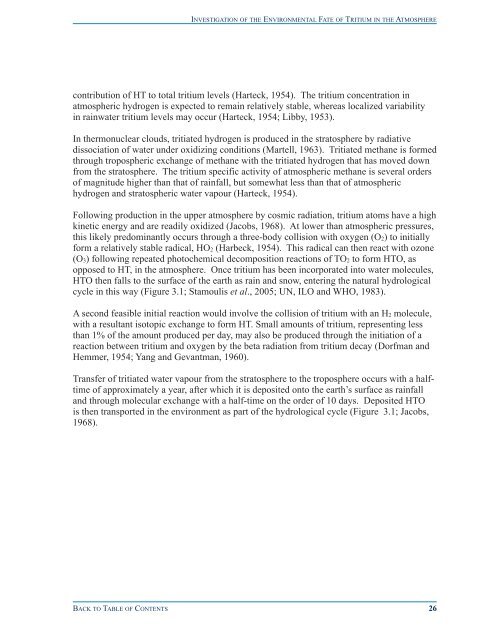Investigation of the Environmental Fate of Tritium in the Atmosphere
Investigation of the Environmental Fate of Tritium in the Atmosphere
Investigation of the Environmental Fate of Tritium in the Atmosphere
You also want an ePaper? Increase the reach of your titles
YUMPU automatically turns print PDFs into web optimized ePapers that Google loves.
INVESTIGATION OF THE ENVIRONMENTAL FATE OF TRITIUM IN THE ATMOSPHERE<br />
contribution <strong>of</strong> HT to total tritium levels (Harteck, 1954). The tritium concentration <strong>in</strong><br />
atmospheric hydrogen is expected to rema<strong>in</strong> relatively stable, whereas localized variability<br />
<strong>in</strong> ra<strong>in</strong>water tritium levels may occur (Harteck, 1954; Libby, 1953).<br />
In <strong>the</strong>rmonuclear clouds, tritiated hydrogen is produced <strong>in</strong> <strong>the</strong> stratosphere by radiative<br />
dissociation <strong>of</strong> water under oxidiz<strong>in</strong>g conditions (Martell, 1963). Tritiated methane is formed<br />
through tropospheric exchange <strong>of</strong> methane with <strong>the</strong> tritiated hydrogen that has moved down<br />
from <strong>the</strong> stratosphere. The tritium specific activity <strong>of</strong> atmospheric methane is several orders<br />
<strong>of</strong> magnitude higher than that <strong>of</strong> ra<strong>in</strong>fall, but somewhat less than that <strong>of</strong> atmospheric<br />
hydrogen and stratospheric water vapour (Harteck, 1954).<br />
Follow<strong>in</strong>g production <strong>in</strong> <strong>the</strong> upper atmosphere by cosmic radiation, tritium atoms have a high<br />
k<strong>in</strong>etic energy and are readily oxidized (Jacobs, 1968). At lower than atmospheric pressures,<br />
this likely predom<strong>in</strong>antly occurs through a three-body collision with oxygen (O2) to <strong>in</strong>itially<br />
form a relatively stable radical, HO2 (Harbeck, 1954). This radical can <strong>the</strong>n react with ozone<br />
(O3) follow<strong>in</strong>g repeated photochemical decomposition reactions <strong>of</strong> TO2 to form HTO, as<br />
opposed to HT, <strong>in</strong> <strong>the</strong> atmosphere. Once tritium has been <strong>in</strong>corporated <strong>in</strong>to water molecules,<br />
HTO <strong>the</strong>n falls to <strong>the</strong> surface <strong>of</strong> <strong>the</strong> earth as ra<strong>in</strong> and snow, enter<strong>in</strong>g <strong>the</strong> natural hydrological<br />
cycle <strong>in</strong> this way (Figure 3.1; Stamoulis et al., 2005; UN, ILO and WHO, 1983).<br />
A second feasible <strong>in</strong>itial reaction would <strong>in</strong>volve <strong>the</strong> collision <strong>of</strong> tritium with an H2 molecule,<br />
with a resultant isotopic exchange to form HT. Small amounts <strong>of</strong> tritium, represent<strong>in</strong>g less<br />
than 1% <strong>of</strong> <strong>the</strong> amount produced per day, may also be produced through <strong>the</strong> <strong>in</strong>itiation <strong>of</strong> a<br />
reaction between tritium and oxygen by <strong>the</strong> beta radiation from tritium decay (Dorfman and<br />
Hemmer, 1954; Yang and Gevantman, 1960).<br />
Transfer <strong>of</strong> tritiated water vapour from <strong>the</strong> stratosphere to <strong>the</strong> troposphere occurs with a halftime<br />
<strong>of</strong> approximately a year, after which it is deposited onto <strong>the</strong> earth’s surface as ra<strong>in</strong>fall<br />
and through molecular exchange with a half-time on <strong>the</strong> order <strong>of</strong> 10 days. Deposited HTO<br />
is <strong>the</strong>n transported <strong>in</strong> <strong>the</strong> environment as part <strong>of</strong> <strong>the</strong> hydrological cycle (Figure 3.1; Jacobs,<br />
1968).<br />
BACK TO TABLE OF CONTENTS 26



